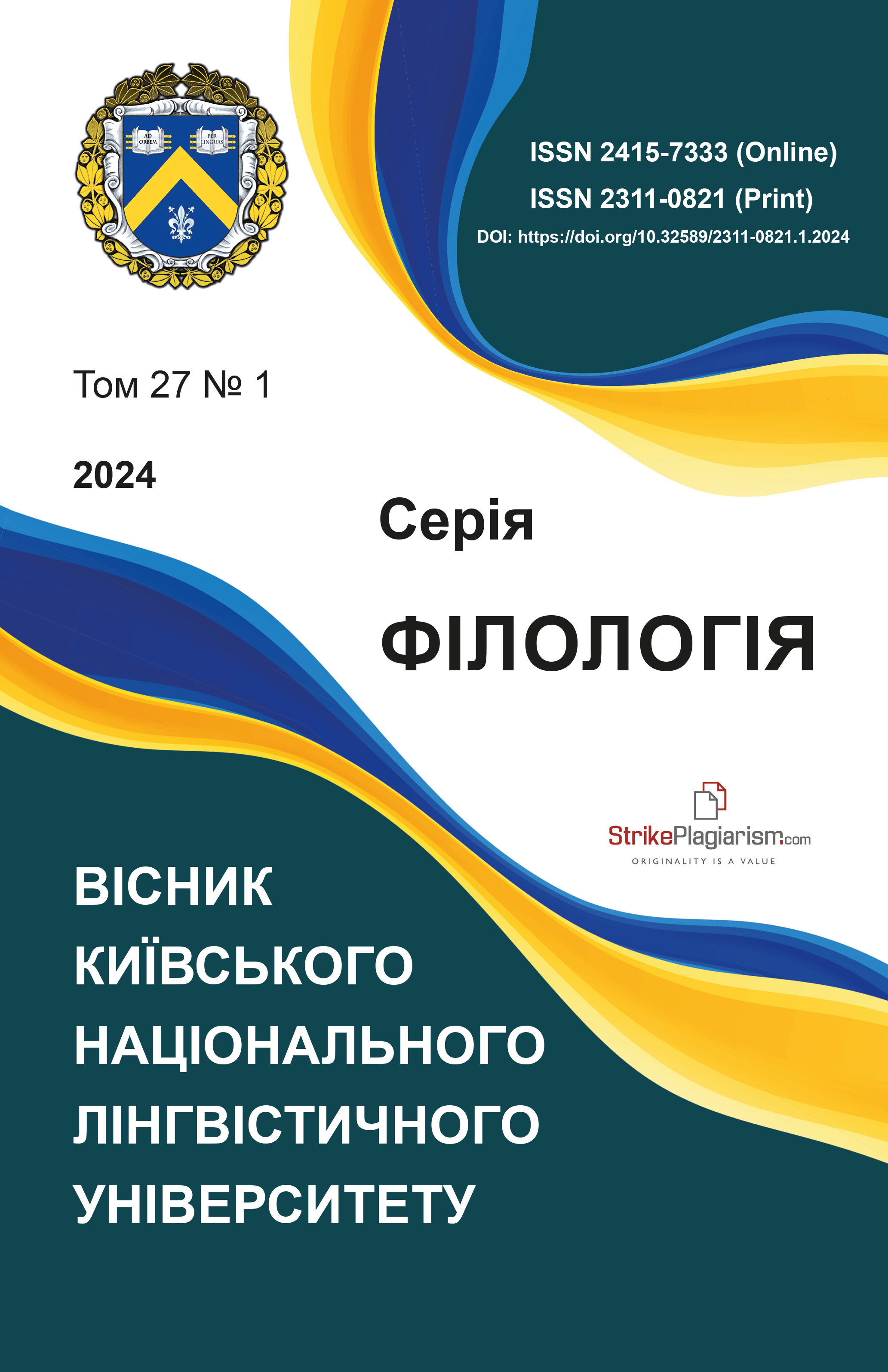Воєнна лінгвістика як нова лінгвосинергетична галузь: відповіді на виклики сучасності
DOI:
https://doi.org/10.32589/2311-0821.1.2024.309607Ключові слова:
воєнна лінгвістика, воєнна комунікація, воєнний дискурс, воєнно-політична термінологія, воєнно-політичний текст, воєнна публіцистика, засоби масової інформаціїАнотація
Статтю присвячено проблематиці воєнної лінгвістики, нового напряму прикладної лінгвістики, що віддзеркалює особливості мовної репрезентації воєнного мистецтва засобами масової інформації. Виявлено потенційні підходи, які визначають змістовно-інформативну грань воєнної лінгвістики як конвергентну з воєнним дискурсом в екзистенційному виклику, на який зреагувала наука. Відповідно предметом дослідження воєнної лінгвістики є мовні засоби теорії оперативного мистецтва (операцій і бойових дій), теорії тактики (підготовка й веденння бою), теорії стратегій (управління військами), орієнтовані на правильне тлумачення воєнного контексту у висвітленні ЗМІ. Описано поняттєвий апарат воєнної лінгвістики й доведено, що всі поняття в його межах функціонують циклічно, завдяки чому зберігається баланс між взаємозв’язком і взаємозалежністю суб’єктів політики, політичних процесів й елементами воєнного дискурсу. З опертям на методологію воєнної стратегії і тактики та лінгвістичної прагматики виокремлено такі поняття, як: воєнна комунікація, воєнний дискурс, воєнно-політична термінологія, воєнно-політичний текст, воєнна публіцистика.
Здійснено узагальнення, що в межах дослідження мовних феноменів воєнного дискурсу та воєнної публіцистики, політичної стратегії країн і корпусних закономірностей текст є продуктом воєнної лінгвістики і вершиною контекстуальної подібності кластерних парадигм у площині
політичної лінгвістики, території і ресурсів, історії та культури, ідеології, економічної політики. У воєнній публіцистиці різні мовні рівні перебувають під впливом російсько-української війни, що характеризується новими тенденціями в тлумаченні мовних змін, спричинених численною з’явою
war-related collocations у газетних виданнях.
Посилання
Gruber, H. (2024). Snyder and Habermas on the war in Ukraine: a critical discourse
analysis of elite media discourse in Germany. Critical Discourse Studies, 1–17.
https://doi.org/10.1080/17405904.2024.2331164
Hamziuk, M. V. (2022). Military-Political Euphemisms in Modern German-Language
Mass Media. Kyiv National Linguistic University. Series Philology, 25 (1), 19–29.
https://doi.org/10.51423/2524-0471-2021-13-2-3
Kharchenko, O. (2023). Citizen journalism in Ukraine and globalozation media processes
during the Russian-Ukrainian war. Integrated communications, 16, 63–66.
https://doi.org/10.28925/2524-2644.2023.167.
Khraban, T. (2021). A Discursive Approach to Modern Ukrainian Non-institutional
Military Discourse. Social Communications: Theory and Practice, 13(2).
Klymanska, L., Klimanska, M., & Haletska, I. (2023). The Discourse of Daily Life during
the War: the 2022 Ukrainian Projection. Journal of Education Culture and Society,
(1), 526–550.
https://doi.org/10.15503/jecs2023.1.526.550
Levkova, A. (2024). Words of War. https://theukrainians.org/slova-vijny/
Martikainen, J., & Sakki, I. (2024). Visual humanization of refugees: A visual rhetorical
analysis of media discourse on the war in Ukraine. Br J Soc Psychol., 63(1), 106–130.
https://doi: 10.1111/bjso.12669.
Selvarajah, S., & Lorenzo, F. (2023). Media, Public Opinion, and the ICC in the Russia–
Ukraine War. Journalism and Media, 4 (3), 760–789.
https://doi.org/10.3390/journalmedia4030048
Taugerbeck, S. (2013). Military Euphemisms in Media Coverage – Euphemisms in special
contexts of war reporting.
https://doi.org/10.13140/RG.2.2.24998.63041.
Ushchyna, V. (2022). From conflict of discourses to military conflict: multimodality of
identity construction in Russo-Ukrainian war discourse. East European Journal of
Psycholinguistics.
https://doi.org/10.29038/eejpl.2022.9.2.ush
Zecchinon, P., & Standaert, O. (2024). The War in Ukraine Through the Prism of Visual
Disinformation and the Limits of Specialized Fact-Checking. A Case-Study at Le
Monde. Digital Journalism, 1–19.
##submission.downloads##
Опубліковано
Номер
Розділ
Ліцензія
1. Дослідження, що публікуються у збірнику наукових праць, повинні бути виконані відповідно до чинного законодавства України та етичних норм. Основний обов’язок автора полягає в тому, щоб виконати таке дослідження, яке заслуговує на об’єктивне обговорення науковою спільнотою його значущості.
2. Автори повинні формулювати свої наукові спостереження у такий спосіб, щоб їхні результати могли бути підтверджені іншими вченими, без підробки отриманих висновків або маніпуляції ними.
3. Автори статей несуть відповідальність за зміст статей і за сам факт їх публікації.
4. Автор повинен цитувати ті публікації, які вплинули на сутність роботи, а також ті, які можуть швидко познайомити читача з попередніми роботами, важливими для розуміння цього дослідження. За винятком оглядів, слід мінімізувати цитування робіт, які не мають безпосереднього відношення до змісту дослідження. Автор зобов’язаний провести джерельний пошук, щоб знайти і процитувати оригінальні публікації, тісно пов’язані з цим матеріалом. Необхідно також коректно вказувати на джерела принципово важливих матеріалів, використаних у цій роботі, якщо вони не були отримані самим автором.
5. Автори повинні дотримуватися усіх чинних вимог щодо публікацій рукописів. Неприпустимим є плагіат та його удавання за оригінальну розвідку, а також подання до редакції раніше опублікованої статті. У випадках виявлення плагіату відповідальність несуть автори поданих матеріалів.
6. Експериментальне або теоретичне дослідження може іноді слугувати основою для науково коректної і об’єктивної критики роботи іншого дослідника. Опубліковані статті в окремих випадках можуть містити подібну критику. Персональна суб’єктивна критика не є доречною за жодних обставин.
7. Співавторами статті мають бути ті особи, науковий внесок яких є вагомим у її зміст та які розділяють відповідальність за здобуті результати. Автор, який подає рукопис до друку, відповідає за те, щоб до списку співавторів були включені всі ті й лише ті особи, які відповідають критеріям авторства. У статті, написаної декількома авторами, той з авторів, хто подає до редакції контактні відомості, документи і листується з редакторами, бере на себе відповідальність за згоду інших авторів статті на її публікацію у збірнику.
8. Автори повинні повідомити редактора про будь-який потенційний конфлікт інтересів, на які могла б вплинути публікація результатів, що містяться у рукописі.
9. Автори повинні чітко вказати джерела всієї процитованої інформації, оформити посилання на наукові джерела відповідно до вимог ДСТУ ГОСТ 7.1:2006.
10. Редколегія має право відмовити у публікації статті за умов недотримання зазначених вимог.
11. Автор може висловити побажання не залучати деяких рецензентів до розгляду рукопису. Проте головний редактор може прийняти рішення залучити одного або декількох із цих рецензентів, якщо переконаний, що їх думки є важливими для неупередженого розгляду рукопису. Таке рішення може бути прийняте, наприклад, у тому випадку, коли є серйозні суперечності між цим рукописом і попередньою роботою потенційного рецензента.
12. Запобігання псевдонауковим публікаціям є відповідальністю кожного автора, головного редактора, рецензента, видавця й організації.


